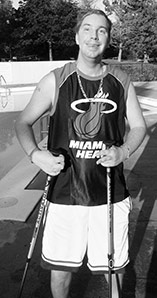From four wheels to two feet
 CREDIT: EVE MOSS
CREDIT: EVE MOSSDalton Moss continues to recover from a brain injury he suffered in Thailand when his motorcycle ran into a truck head-on.
What would it be like to die and be brought back to life? It's an inconceivable event for most of us, but this was a reality for Dalton Moss.
Dalton travelled to Chiang Rai, Thailand for his 21st birthday in 2001, when he came head to head with what would be his trying future.
“He was up in the mountains on a big motorcycle,” said his mother, Eve Moss. “He had a phone call and took off his helmet � When he was finished he didn't put his helmet back on because it wasn't raining anymore. He went around a corner, hit an army truck head-on. He hit the grill, went underneath the vehicle, and he was pretty much almost dead.”
Dalton's jaw completely dislocated, and he was covered in blood from head to toe. He lied on the burning hot pavement, so hot it melted his legs through his thin pants, and yet people were mugging him. His last chance at life was left in the hands of the doctors in Thailand.
“He died, and they brought him back to life,” said Eve. “They just don't give up on you; they will not let a person die!”
Dalton suffered a broken ankle and forearm, a multitude of abrasions, and severe brain injuries that cost him his memory and landed him in a coma for three months. When he finally woke up, he was like a baby — he couldn't walk, and he couldn't talk.
Dalton is now 32 but his mental age ranges daily from about 12 to 32 years old.
After six months of what seemed like endless life-threatening surgeries, Dalton and his mother returned home to British Columbia. Seeking treatment became the next hurdle. Eve describes his treatment at Langley Hospital as “abuse.”
“You'd have to threaten them to get to do anything because he was getting so infected ... His trachea was green, and I basically had to go to the news media to get them to do anything. It was a living nightmare, what they did to my son, and nobody cared.”
So Eve sought treatment at GF Strong Rehabilitation Centre, where Dalton began learning independence. He was released after three months, but he still had a very long way to go. Finally, the heath system in B.C. forced them to move to Ontario.
“Physio was just hit and miss here and there for a few months,” Eve said, “but that's no way to help anybody, you don't improve.”
B.C. only produces 40 physiotherapy graduates annually, but there are 200 jobs to fill. At this point, the University of British Columbia is the only post-secondary establishment to offer a physiotherapy graduate program. Meanwhile, Ontario sees 265 physiotherapy graduates annually. But Eve said it's not just the lack of physiotherapists in B.C. that's the problem; she felt as though they used her son as an experiment.
“Because he has such a multitude of things that are all working against each other � they couldn't figure it out in B.C., so they were just doing it because they were getting paid for it.”
The stars finally aligned for Eve and Dalton when they found treatment in London.
“The therapist watched him just for the first time and instantly she knew where all the problems were,” said Eve.
Now Dalton walks with a cane, though he still struggles with balance. Until recently, government funding covered all of his treatments. Any further treatments must be paid for out of pocket because Dalton's physiotherapist said he has reached the point where he will no longer reap the benefits of physiotherapy.
Dalton was invited to a physiotherapy rehabilitation class focused on traumatic brain injury at Western University. The students could see the before and after effects of what physiotherapy can do for a person never expecting to walk again. Caroline Trajan was one of the students who attended the class.
“We all did a subjective interview, asked him about the incident. Dalton's speaking can be hard to understand, so it was a lesson to us in communicating with people with brain injuries.”
Trajan's placements have opened her eyes to issues in the field.
“There's a lack of funding in a lot of areas. Physiotherapy being second tier in health care in Canada doesn't necessarily get the attention that other areas of health care do. I know that a lot of patients like Dalton get kicked off the case load, maybe prematurely, definitely while they could still benefit from the care.”
Dorianne Sauve, the CEO of the Ontario Physiotherapy Association, said, “For those who have extended health benefit plans, there's lots of private clinic options out there.”
Eve Moss lives solely on a disability cheque from the government to support herself and her son, and she does not have enough money to pay for private treatment.
“If I go back to the '80s, I would say that 80 per cent of physiotherapists worked in the public sector and 20 per cent worked in the private sector,” said Sauve. “Now we're closer to about 50/50, if not a bit more in the private sector ... What we're looking at is whether or not the system is built and there's funding available for physiotherapists to provide services in the public sector.”
It's the patients who have chronic illnesses or long-term disabilities who are the most vulnerable. They don't often fit into the eligibility requirements. People who fall between the gaps in public funding are the ones who aren't able to pay, don't have extended health benefits, aren't covered by WSIB or insurance, and don't fall into any specific programming that are offered within the public system. These people often don't get the treatment they need.
Ontario specifically faces issues related to geographical access.
“I think we're challenged in having the same access when we move away from our major centres in Ontario,” said Sauve. “What we're seeing over and over again in small and medium communities is where a small reduction occurs, or someone says, ‘We will no longer offer this service at this hospital site, we're only going to offer it at this other hospital site which is in another town' ... People are having a hard time navigating getting that care and oftentimes having to choose to go without because they can't afford private services.”
The value of physiotherapy is huge. It can cut hospital wait times, it can help people regain independence, and it can help health care workers discover the root problems of dysfunction.
Sauve said, “It reduces a huge amount of the cost to the health care system because if someone's able to be active and mobile and out there, then they don't show back up at the hospital.”
Dalton Moss is an exceptional example of the skill physiotherapists in Ontario possess. He came in a wheelchair and left on his feet.













